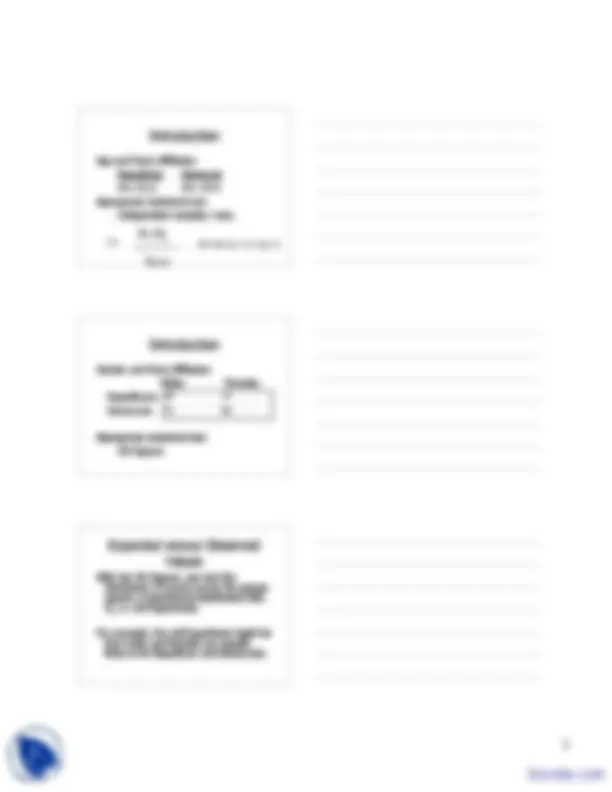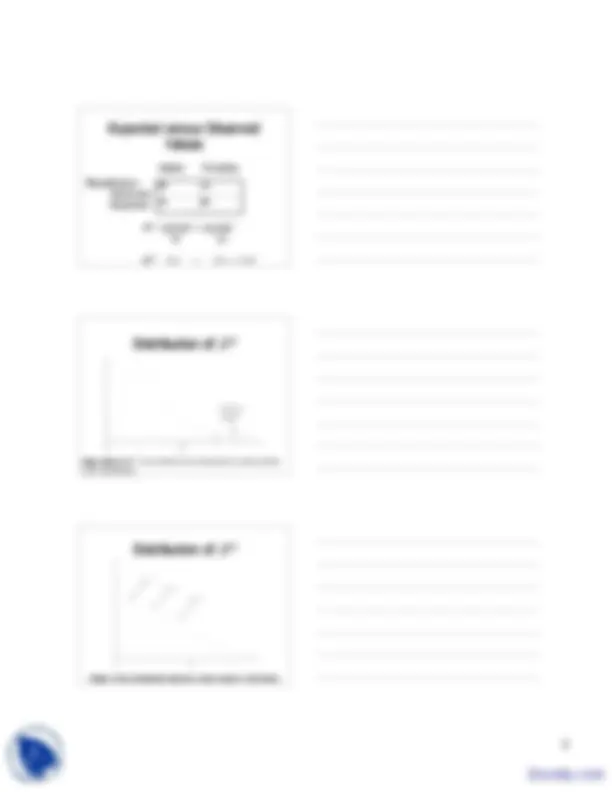






Study with the several resources on Docsity

Earn points by helping other students or get them with a premium plan


Prepare for your exams
Study with the several resources on Docsity

Earn points to download
Earn points by helping other students or get them with a premium plan
Community
Ask the community for help and clear up your study doubts
Discover the best universities in your country according to Docsity users
Free resources
Download our free guides on studying techniques, anxiety management strategies, and thesis advice from Docsity tutors
An introduction to the chi-square test, its applications in testing hypotheses with frequency data, and the steps involved in performing the test using spss. The concepts of expected versus observed values, the distribution of chi-square, interpreting spss printouts, and reporting the results.
Typology: Slides
1 / 8

This page cannot be seen from the preview
Don't miss anything!





The Chi-Square Tests for Goodness of Fit And Independence The Chi-Square I. Introduction II. Expected versus Observed Values III. Distribution of X 2 IV. Interpreting SPSS printouts of Chi-Square V. Reporting the Results of Chi-Square VI. Assumptions of Chi-Square Introduction Often when we are testing hypotheses, we only have frequency data. Our hypothesis concern the distributions of the frequencies across various categories. Examples: Are there an equal number of males and females in a group? Are Republicans more likely to be Fundamentalist Christians than Democrats?
Introduction With these data we have the number of people of a certain type in a category. This is qualitative, not quantitative date. The scale of measurement is nominal. Compare this to age as a variable. Age is a quantitative variable, measured on a ratio scale. Introduction If one were to ask are Republicans older than Democrats, then one could measure the age of a sample of people in each group, calculate the means of each sample, and test if the difference in the sample means is statistically significant (i.e., the sample means represent a difference in the population mean). Introduction Compare this to the question: “Are Republicans more likely to be males than Democrats?” Our sample would contain a number of males and females. We would not want to calculate a mean gender.
Expected versus Observed Values For example, in a sample of 100 Republicans, the null hypothesis might be that there would be 50 males and 50 females. Expected values: Males Females Republicans: 50 50 Expected versus Observed Values However, what if you know the population is 60 percent female, then the expected values should be as follows: Males Females Republicans: 40 60 Expected versus Observed Values In any random sample of 100 people, I will not observe exactly 60 females and 40 males, any more than I get exactly 50 heads in a 100 coin tosses. Chi Square measures the difference between the observed values and the expected values, and compares that difference to what one might expect by chance. Chi-square = Χ^2 = (fo -fe)^2 fe
Expected versus Observed Values 40 60 58 42 Males Females Republicans: Observed Expected Χ^2 = (58-40)^2 + (42-60)^2 40 60 Χ2 =^ 8.1 + 5.4 = 13. Distribution of X 2 Large values of X 2 are unlikely to be observed by chance alone (null hypothesis). Distribution of X 2 Shape of the distribution depends on the degrees of freedom.
With two dimensions: 2 X 2 Chi-Square Gender and Party Affiliation (expected values) Males Females Republicans Democrats 150128/250 = 76.8 150122/250 = 73. 100122/ = 48. 1 00128/ = 51. Totals 100 150 Totals 128 122 250 Use these values to calculate Chi Square: Χ^2 = (fo -fe)^2 fe Interpreting SPSS printouts of Chi-Square Data Structure: Case Processing Summary Cases Va N lid (^) Percent MisN sing (^) Percent TNot al Percent Party * Gender 250 100 .0% 0 .0% 250 10 Party * Gender Crosstabulation Gender Party RepublicanCount mal 58 e^ femal 42 e^ Tota 100 l Expected Count 5 1.2 4 8.8 10 0. Democrat Count 70 80 150 Expected Count 76. 8 73.2 150. Total Count 128 122 250 Expected Count 12 8.0 122 Interpreting SPSS printouts of Chi-Square
Chi-Square Tests Value df Asymp. Sig. Exact Sig. Exact Sig. (2-sided) (2-sided) (1-sided) Pearson Chi-Square 3.08 4 a^1. Continuity Correction 2.648 1. Likelihood Ratio 3.094 1. Fisher's Exact Test .093. Linear-by-Linear 3.072 1. 080 Association N of Valid Cases 250 a. 0 cells (.0%) have expected count less than 5. The minimum expected count is 48.80. b. Computed only for a 2x2 table
Compare this value to alpha (.05)
“A Chi Square test was performed to determine if males and females were distributed differently across the political parties. The test failed to indicate a significant difference, Χ^2 (1) = 3.08, p = .079 (an alpha level of. was adopted for this and all subsequent statistical tests).”